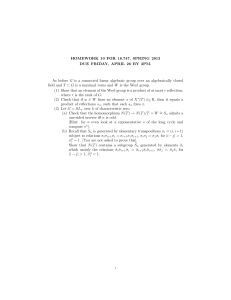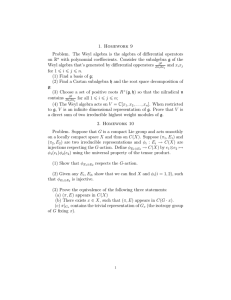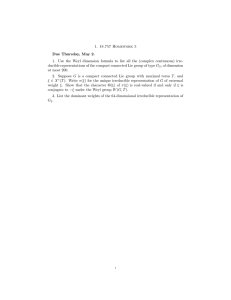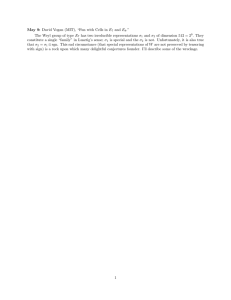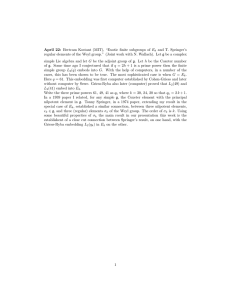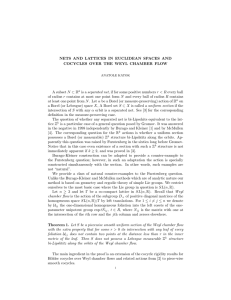PUBLICATIONS DE L’INSTITUT MATHÉMATIQUE Nouvelle série, tome 94 (108) (2013), 91–98
advertisement
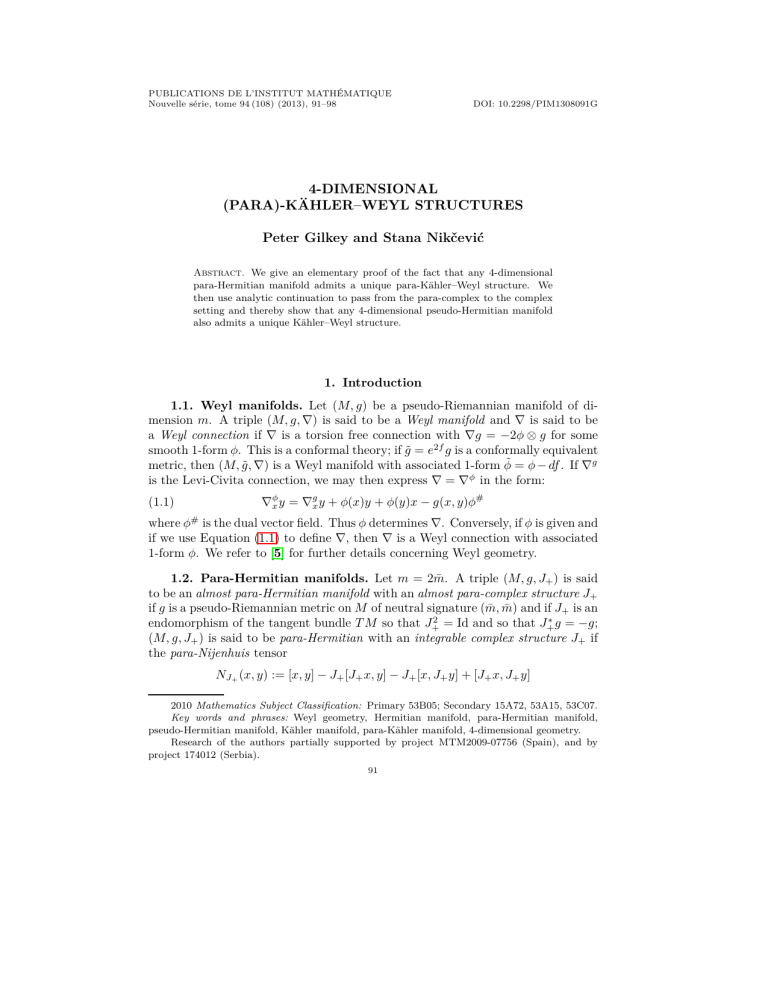
PUBLICATIONS DE L’INSTITUT MATHÉMATIQUE
Nouvelle série, tome 94 (108) (2013), 91–98
DOI: 10.2298/PIM1308091G
4-DIMENSIONAL
(PARA)-KÄHLER–WEYL STRUCTURES
Peter Gilkey and Stana Nikčević
Abstract. We give an elementary proof of the fact that any 4-dimensional
para-Hermitian manifold admits a unique para-Kähler–Weyl structure. We
then use analytic continuation to pass from the para-complex to the complex
setting and thereby show that any 4-dimensional pseudo-Hermitian manifold
also admits a unique Kähler–Weyl structure.
1. Introduction
1.1. Weyl manifolds. Let (M, g) be a pseudo-Riemannian manifold of dimension m. A triple (M, g, ∇) is said to be a Weyl manifold and ∇ is said to be
a Weyl connection if ∇ is a torsion free connection with ∇g = −2φ ⊗ g for some
smooth 1-form φ. This is a conformal theory; if g̃ = e2f g is a conformally equivalent
metric, then (M, g̃, ∇) is a Weyl manifold with associated 1-form φ̃ = φ − df . If ∇g
is the Levi-Civita connection, we may then express ∇ = ∇φ in the form:
(1.1)
∇φx y = ∇gx y + φ(x)y + φ(y)x − g(x, y)φ#
where φ# is the dual vector field. Thus φ determines ∇. Conversely, if φ is given and
if we use Equation (1.1) to define ∇, then ∇ is a Weyl connection with associated
1-form φ. We refer to [5] for further details concerning Weyl geometry.
1.2. Para-Hermitian manifolds. Let m = 2m̄. A triple (M, g, J+ ) is said
to be an almost para-Hermitian manifold with an almost para-complex structure J+
if g is a pseudo-Riemannian metric on M of neutral signature (m̄, m̄) and if J+ is an
2
∗
endomorphism of the tangent bundle T M so that J+
= Id and so that J+
g = −g;
(M, g, J+ ) is said to be para-Hermitian with an integrable complex structure J+ if
the para-Nijenhuis tensor
NJ+ (x, y) := [x, y] − J+ [J+ x, y] − J+ [x, J+ y] + [J+ x, J+ y]
2010 Mathematics Subject Classification: Primary 53B05; Secondary 15A72, 53A15, 53C07.
Key words and phrases: Weyl geometry, Hermitian manifold, para-Hermitian manifold,
pseudo-Hermitian manifold, Kähler manifold, para-Kähler manifold, 4-dimensional geometry.
Research of the authors partially supported by project MTM2009-07756 (Spain), and by
project 174012 (Serbia).
91
92
GILKEY AND NIKČEVIĆ
vanishes or, equivalently, if there are local coordinates (u1 , . . . , um̄ , v 1 , . . . , v m̄ ) centered on an arbitrary point of M so that J+ ∂ui = ∂vi and J+ ∂vi = ∂ui .
1.3. Pseudo-Hermitian manifolds. Let m = 2m̄. A triple (M, g, J− ) is
said to be an almost pseudo-Hermitian manifold with an almost complex structure
J− if (M, g) is a pseudo-Riemannian manifold, if J− is an endomorphism of the
2
∗
tangent bundle so that J−
= − id and so that J−
g = g; (M, g, J− ) is said to be a
pseudo-Hermitian manifold with an integrable complex structure J− if the Nijenhuis
tensor
NJ− (x, y) := [x, y] + J− [J− x, y] + J− [x, J− y] − [J− x, J− y]
vanishes or, equivalently, if there are local coordinates (u1 , . . . , um̄ , v 1 , . . . , v m̄ ) centered on an arbitrary point of M so that J− ∂ui = ∂vi and J− ∂vi = −∂ui .
1.4. Para-Kähler and Kähler manifolds. One says that a Weyl connection
∇ on a para-Hermitian manifold (M, g, J+ ) is a para-Kähler–Weyl connection if
∇J+ = 0. Similarly, one says that a Weyl connection ∇ on a pseudo-Hermitian
manifold (M, g, J− ) is a Kähler–Weyl connection if ∇J− = 0. Since ∇J± = 0
implies J± to be integrable, we assume this condition henceforth. If ∇ = ∇g is the
Levi-Civita connection, then (M, g, J± ) is said to be (para)-Kähler.
Let ⋆ be the Hodge operator and let Ω± (x, y) := g(x, J± y) be the (para)-Kähler
form. The co-derivative δΩ± is given, see [2] for example, by δΩ± = − ⋆ d ⋆ Ω± .
The following is well known – see, for example, the discussion in [9] of the
Riemannian setting (which uses results of [10, 11]) and the generalization given in
[3] to the more general context.
Theorem 1.1. Let m > 6. If (M, g, J± , ∇) is a (para)-Kähler–Weyl structure,
then the associated Weyl structure is trivial, i.e., there is always locally a conformally equivalent metric g̃ = e2f g so that (M, g̃, J± ) is (para)-Kähler and so that
∇ = ∇g̃ .
By Theorem 1.1, only the 4-dimensional setting is relevant. The following is
the main result of this short note; it plays a central role in the discussion of [1].
Theorem 1.2. (1) If M = (M, g, J+ ) is a para-Hermitian manifold of signature (2, 2), then there is a unique para-Kähler–Weyl structure on M with
φ = 21 J+ δΩ+ .
(2) If M = (M, g, J− ) is a pseudo-Hermitian manifold of signature (2, 2), then
there is a unique Kähler–Weyl structure on M with φ = − 12 J− δΩ− .
(3) If M = (M, g, J− ) is a Hermitian manifold of signature (0, 4), then there
is a unique Kähler–Weyl structure on M with φ = − 21 J− δΩ− .
Assertion (3) of Theorem 1.2, which deals with the Hermitian setting, is well
known – see, for example, the discussion in [8]. Subsequently, Theorem 1.2 was
established in full generality (see [3, 4]) by extending the Higa curvature decomposition [6, 7] from the real to the Kähler–Weyl and to the para-Kähler Weyl
contexts.
Here is a brief outline to this paper. In Section 2, we show that if a (para)Kähler–Weyl structure exists, then it is unique. In Section 3, we give a direct
4-DIMENSIONAL (PARA)-KÄHLER–WEYL STRUCTURES
93
proof of Assertion (1) of Theorem 1.2 in the para-Hermitian setting. In Section 4,
we use analytic continuation to derive Assertions (2) and (3), which deal with the
complex setting, from Assertion (1). This reverses the usual procedure of viewing
para-complex geometry setting as an adjunct to complex geometry and is a novel
feature of this paper.
2. Uniqueness of the (para)-Kähler–Weyl structure
This section is devoted to the proof of the following uniqueness result.
Lemma 2.1. (1) If ∇φ1 and ∇φ2 are two para-Kähler–Weyl connections on a
4-dimensional para-Hermitian manifold (M, g, J+ ), then φ1 = φ2 .
(2) If ∇φ1 and ∇φ2 are two Kähler–Weyl connections on a 4-dimensional
pseudo-Hermitian manifold (M, g, J− ), then φ1 = φ2 .
Proof. Let φ = φ1 − φ2 and let ΘX (Y ) = φ(X)Y + φ(Y )X − g(X, Y )φ# . By
Equation (1.1), ∇φX1 − ∇φX2 = ΘX ∈ End(T M ). Consequently, {∇φ1 − ∇φ2 }J± = 0
implies [ΘX , J± ] = 0 for all X.
We first deal with the para-Hermitian case. This is a purely algebraic computation. Let {e1 , e2 , e3 , e4 } be a local frame for T M so that
(2.1)
J+ e1 = e1 ,
J+ e2 = e2 ,
J+ e3 = −e3 ,
g(e1 , e3 ) = g(e2 , e4 ) = 1.
J+ e4 = −e4 ,
We expand φ = a1 e1 + a2 e2 + a3 e3 + a4 e4 and compute:
Θe1 e4 = a1 e4 + a4 e1 , J+ Θe1 e4 = −a1 e4 + a4 e1 , Θe1 J+ e4 = −a1 e4 − a4 e1 ,
Θe2 e3 = a2 e3 + a3 e2 , J+ Θe2 e3 = −a2 e3 + a3 e2 , Θe2 J+ e3 = −a2 e3 − a3 e2 ,
Θe4 e1 = a4 e1 + a1 e4 , J+ Θe4 e1 =
Θe3 e2 = a3 e2 + a2 e3 , J+ Θe3 e2 =
a4 e1 − a1 e4 , Θe4 J+ e1 =
a3 e2 − a2 e3 , Θe3 J+ e2 =
a4 e 1 + a1 e 4 ,
a3 e 2 + a2 e 3 .
Equating Θei J+ ej with J+ Θei ej then implies a1 = a2 = a3 = a4 = 0 so φ = 0 and
φ1 = φ2 . This establishes Assertion (1).
Next assume we are in the pseudo-Hermitian setting. Complexify and extend
g to be complex bilinear. Choose a local frame {Z1 , Z2 , Z̄1 , Z̄2 } for T M ⊗R C so
√
√
J− Z2 = −1Z2 ,
J− Z1 = −1Z1 ,
√
√
J− Z̄1 = − −1Z̄1 , J− Z̄2 = − −1Z̄2 ,
g(Z1 , Z̄1 ) = 1,
g(Z2 , Z̄2 ) = ε2
where we take
√ ε2 = +1 in signature (0, 4) and ε2 = −1 in signature (2, 2). We
set J+ := − −1J− , e1 := Z1 , e2 := Z2 , e3 := Z̄1 , and e4 := ε2 Z̄2 and apply the
argument given to prove Assertion (1) (where the coefficients ai are now complex)
to derive Assertion (2).
94
GILKEY AND NIKČEVIĆ
3. Para-Hermitian geometry
3.1. The algebraic context. Let (V, h·, ·i, J+ ) be a para-Hermitian vector
space of dimension 4. Here h·, ·i is an inner product on V of signature (2, 2) and J+
2
∗
is an endomorphism of V satisfying J+
= Id and J+
h·, ·i = −h·, ·i. We may then
4
choose a basis {e1 , e2 , e3 , e4 } for V = R so that the relations of Equation (2.1) are
satisfied. The Kähler form and orientation µ are then given by
Ω+ = −e1 ∧ e3 − e2 ∧ e4
and µ = 12 Ω+ ∧ Ω+ = e1 ∧ e3 ∧ e2 ∧ e4 .
Let ⋆ be the Hodge operator, characterized by
ω1 ∧ ⋆ω2 = hω1 , ω2 ie1 ∧ e3 ∧ e2 ∧ e4 for all ωi .
Consequently:
(3.1)
⋆ e1 ∧ e3 = −e2 ∧ e4 ,
⋆ e1 ∧ e2 ∧ e3 = −e2 ,
⋆ e1 ∧ e3 ∧ e4 = −e4 ,
⋆ e2 ∧ e4 = −e1 ∧ e3 ,
⋆ e1 ∧ e2 ∧ e4 =
⋆ e2 ∧ e3 ∧ e4 =
e1 ,
e3 .
3.2. Example. We begin the proof of Theorem 1.2 by considering a very
specific example. Let (x1 , x2 , x3 , x4 } be the usual coordinates on R4 , let ∂i := ∂xi ,
and let J+ be the standard para-complex structure:
J+ ∂1 = ∂1 ,
J+ ∂2 = ∂2 ,
J+ ∂3 = −∂3 ,
J+ ∂4 = −∂4 .
Let f (0) = 0. We take the metric to have non-zero components determined by
g(∂1 , ∂3 ) = 1 and g(∂2 , ∂4 ) = e2f . Let fi := {∂i f }(0). The (possibly) non-zero
Christoffel symbols of ∇g at the origin are given by:
g(∇g∂1 ∂2 , ∂4 ) = g(∇g∂2 ∂1 , ∂4 ) = g(∇g∂1 ∂4 , ∂2 ) = g(∇g∂4 ∂1 , ∂2 ) = f1 ,
g(∇g∂3 ∂2 , ∂4 ) = g(∇g∂2 ∂3 , ∂4 ) = g(∇g∂3 ∂4 , ∂2 ) = g(∇g∂4 ∂3 , ∂2 ) = f3 ,
g(∇g∂4 ∂4 , ∂2 ) = 2f4 ,
g(∇g∂2 ∂4 , ∂1 ) = g(∇g∂4 ∂2 , ∂1 ) = −f1 ,
g(∇g∂2 ∂2 , ∂4 ) = 2f2 ,
g(∇g∂2 ∂4 , ∂3 ) = g(∇g∂4 ∂2 , ∂3 ) = −f3 .
Consequently the (possibly) non-zero covariant derivatives at the origin are:
∇g∂1 ∂2 = ∇g∂2 ∂1 = f1 ∂2 ,
∇g∂3 ∂2 = ∇g∂2 ∂3 = f3 ∂2 ,
∇g∂4 ∂4 = 2f4 ∂4 ,
∇g∂1 ∂4 = ∇g∂4 ∂1 = f1 ∂4 ,
∇g∂3 ∂4 = ∇g∂4 ∂3 = f3 ∂4 ,
∇g∂2 ∂2 = 2f2 ∂2 ,
∇g∂2 ∂4 = ∇g∂4 ∂2 = −f1 ∂3 − f3 ∂1 .
Since ∇g∂1 and ∇g∂3 are diagonal, they commute with J+ so ∇g∂1 (J+ ) = ∇g∂3 (J+ ) = 0.
We compute
(∇g∂2 J+ )∂1 = (1 − J+ )∇g∂2 ∂1 = (1 − J+ )f1 ∂2 = 0,
(∇g∂2 J+ )∂2 = (1 − J+ )∇g∂2 ∂2 = (1 − J+ )2f2 ∂2 = 0,
(∇g∂2 J+ )∂3 = (−1 − J+ )∇g∂2 ∂3 = (−1 − J+ )f3 ∂2 = −2f3 ∂2 ,
(∇g∂2 J+ )∂4 = (−1 − J+ )∇g∂2 ∂4 = (−1 − J+ )(−f1 ∂3 − f3 ∂1 ) = 2f3 ∂1 ,
4-DIMENSIONAL (PARA)-KÄHLER–WEYL STRUCTURES
95
(∇g∂4 J+ )∂1 = (1 − J+ )∇g∂4 ∂1 = (1 − J+ )f1 ∂4 = 2f1 ∂4 ,
(∇g∂4 J+ )∂2 = (1 − J+ )∇g∂4 ∂2 = (1 − J+ )(−f1 ∂3 − f3 ∂1 ) = −2f1∂3 ,
(∇g∂4 J+ )∂3 = (−1 − J+ )∇g∂4 ∂3 = (−1 − J+ )f3 ∂4 = 0,
(∇g∂4 J+ )∂4 = (−1 − J+ )∇g∂4 ∂4 = (−1 − J+ )2f4 ∂4 = 0.
We apply Equation (3.1). We have ⋆Ω+ = −Ω+ . Setting e1 = dx1 , e2 = ef dx2 ,
e3 = dx3 , and e4 = ef dx4 and recalling f (0) = 0 yields
⋆Ω+ = −Ω+ = dx1 ∧ dx3 + e2f dx2 ∧ dx4 ,
d ⋆ Ω+ = 2f1 dx1 ∧ dx2 ∧ dx4 − 2f3 dx2 ∧ dx3 ∧ dx4 ,
δg Ω+ (0) = − ⋆ d ⋆ Ω+ (0) = −2f1 dx1 + 2f3 dx3 ,
φ(0) = 12 Jδg Ω+ = −f1 dx1 − f3 dx3 , and φ# = −f1 ∂3 − f3 ∂1 .
Let Θij := φ(∂i )∂j + φ(∂j )∂i − g(∂i , ∂j )φ# = (∇φ − ∇g )∂i ∂j at 0. Then:
Θ11 = −2f1 ∂1 , Θ12 = −f1 ∂2 , Θ13 = (−f1 ∂3 − f3 ∂1 ) + (f1 ∂3 + f3 ∂1 ) = 0,
Θ14 = −f1 ∂4 ,
Θ22 = 0, Θ23 = −f3 ∂2 , Θ24 = (f1 ∂3 + f3 ∂1 ),
Θ33 = −2f3 ∂3 , Θ34 = −f3 ∂4 ,
Θ44 = 0.
Since Θ(∂1 ) and Θ(∂3 ) are diagonal, [Θ(∂1 ), J+ ] = [Θ(∂3 ), J+ ] = 0. We compute:
[Θ(∂2 ), J+ ]∂1 = (1 − J+ )Θ12 = 0,
[Θ(∂2 ), J+ ]∂2 = (1 − J+ )Θ22 = 0,
[Θ(∂2 ), J+ ]∂3 = (−1 − J+ )Θ23 = 2f3 ∂2 ,
[Θ(∂2 ), J+ ]∂4 = (−1 − J+ )Θ24 = −2f3 ∂1 ,
[Θ(∂4 ), J+ ]∂1 = (1 − J+ )Θ14 = −2f1 ∂4 ,
[Θ(∂4 ), J+ ]∂2 = (1 − J+ )Θ24 = 2f1 ∂3 ,
[Θ(∂4 ), J+ ]∂3 = (−1 − J+ )Θ34 = 0,
[Θ(∂4 ), J+ ]∂4 = (−1 − J)Θ44 = 0.
We now observe that [∇g , J+ ] + [Θ, J+ ] = 0. Consequently ∇φ J+ = 0 for this
metric and Assertion (1) of Theorem 1.2 holds in this special case.
2
Proof of Theorem 1.2 (1). Let V = R4 , let S−
be the vector space of
∗
symmetric 2-cotensors ω so that J+ ω = −ω, and let ε ∈ C ∞ (S 2 ) satisfy ε(0) = 0.
We use ε to define a perturbation of the flat metric by setting:
g = dx1 ◦ dx3 + dx2 ◦ dx4 + ε.
This is non-degenerate near the origin. Since only the 1-jets of ε are relevant in
2
examining ∇φ (J+ )(0), this is a linear problem and we may take ε ∈ S−
⊗ V ⋆ so:
X
g = g0 +
xi ε(ei ).
i
96
GILKEY AND NIKČEVIĆ
Then ε → (∇φ J+ )(0) defines a linear map
E : S− (V ) ⊗ V ∗ → End(V ) ⊗ V ∗ or equivalently
E : S− (V ) → Hom(V ∗ , End(V ) ⊗ V ∗ ).
The analysis of Section 3.2 shows that E(dx2 ◦ dx4 ) = 0. Permuting the indices
1 ↔ 2 and 3 ↔ 4 then yields E(dx1 ◦ dx3 ) = 0. The question is invariant under the
action of the para-unitary group; we must preserve J+ and we must preserve the
inner product at the origin. Define a unitary transformation T by setting:
T (e1 ) = e1 + ae2 ,
T (e2 ) = e2 ,
T (e3 ) = e3 ,
T (e4 ) = e4 − ae3 .
Then
T (e1 ◦ e3 ) = e1 ◦ e3 + ae2 ◦ e3 .
Consequently, E(e2 ◦ e3 ) = 0. Permuting the indices 1 ↔ 2 and 3 ↔ 4 then yields
E(e1 ◦ e4 ) = 0. Since S− = Span{e1 ◦ e3 , e1 ◦ e4 , e2 ◦ e3 , e2 ◦ e4 }, we see that E = 0
in general; this completes the proof of Assertion (1) of Theorem 1.2.
4. Hermitian and pseudo-Hermitian manifolds
In this section, we will use analytic continuation to derive Theorem 1.2 in the
complex setting from Theorem 1.2 in the para-complex setting. Let V = R4 with
the usual basis {e1 , e2 , e3 , e4 } and coordinates {x1 , x2 , x3 , x4 }, where we expand
v = x1 e1 + x2 e2 + x3 e3 + x4 e4 . Let S 2 denote the space of symmetric 2-tensors.
We complexify and consider
S := S 2 ⊗R C ⊕ (V ∗ ⊗R S 2 ) ⊗R C .
2
Let J+ ∈ M2 (C) be a complex 2 × 2 matrix with J+
= Id and Tr(J+ ) = 0. Let
(4.1)
∗
S(J+ ) := {(g0 , g1 ) ∈ S : det(g0 − J+
g0 ) 6= 0}.
For (g0 , g1 ) ∈ S(J+ ), define:
g(x)(X, Y ) := 21 g0 (X, Y ) − g0 (J+ X, J+ Y )
+
4
X
i=1
xi ·
1
2
g1 (ei , X, Y ) − g1 (ei , J+ X, J+ Y ) .
By Equation (4.1), this is non-degenerate at 0 and defines a complex metric on some
∗
neighborhood of 0 so J+
g = −g. Let ∇g be the complex Levi-Civita connection:
∇g∂i ∂j = 12 g kl {∂i gjl + ∂j gil − ∂xl gij }∂k .
Then ∇g is a torsion free connection on TC M := TM ⊗R C. The para-Kähler form
is defined by setting Ω+ (x, y) = g(x, J+ y) and we have
δΩ+ = ⋆dΩ+ and φ := 21 J+ δg Ω.
We then use φ to define a complex Weyl connection ∇φ on TC M and define a
holomorphic map from S(J+ ) to V := V ∗ ⊗ M4 (C) by setting
E(g0 , g1 ; J+ ) := ∇φ (J+ )|x=0 .
4-DIMENSIONAL (PARA)-KÄHLER–WEYL STRUCTURES
Lemma 4.1.
(g0 , g1 ) ∈ S(J+ ).
(1) If J+ is
(2) If J+ is
(3) If J+ is
97
2
Let J+ ∈ M4 (C) with J+
= id and Tr(J+ ) = 0. Suppose that
real and if (g0 , g1 ) is real, then E(g0 , g1 ; J+ ) = 0.
real and if (g0 , g1 ) is complex, then E(g0 , g1 ; J+ ) = 0.
complex and if (g0 , g1 ) is complex, then E(g0 , g1 ; J+ ) = 0.
Proof. Assertion (1) follows from Theorem 1.2 (1). We argue as follows to
prove Assertion (2). S(J+ ) is an open dense subset of S and inherits a natural
holomorphic structure thereby. Assume that J+ is real. The map E is a holomorphic
map from S(J+ ) to V. By Assertion (1), E(g0 , g1 ; J+ ) vanishes if (g0 , g1 ) is real.
Thus, by the identity theorem, E(g0 , g1 ; J+ ) vanishes for all (g0 , g1 ) ∈ SJ+ . This
establishes Assertion (2) by removing the assumption that (g0 , g1 ) is real.
We complete the proof by removing the assumption that J+ is real. The general linear group GL4 (C) acts on the structures involved by change of basis (i.e.,
conjugation). Let (g0 , g1 ) ∈ S(J+ ) where J+ is real and Tr(J+ ) = 0. We consider
the real and complex orbits
OR (g0 , g1 ; J+ ) := GL4 (R) · (g0 , g1 ; J+ ),
OC (g0 , g1 ; J+ ) := GL4 (C) · (g0 , g1 ; J+ ).
Let F (A) := E(A · (g0 , g1 ; J+ )) define a holomorphic map from GL4 (C) to V. By
Assertion (2), F vanishes on GL4 (R). Thus by the identity theorem, F vanishes on
GL4 (C) or, equivalently, E vanishes on the orbit space OC (g0 , g1 ; J+ ). Given any
2
J+ ∈ M4 (C) with J+
= Id and Tr(J+ ) = 0, we can choose A ∈ GL4 (C) so that
A · J+ is real. The general case now follows from Assertion (2).
Proof of Theorem 1.2 (2,3). Let (M, g, J− ) be a 4-dimensional pseudo-Hermitian manifold of dimension 4. Fix a point P of M . Since J− is integrable, we
may choose local coordinates (x1 , x2 , x3 , x4 ) so the matrix of J− relative to the
coordinate frame {∂i } is constant. Define a Weyl connection with associated 1form given by φ = − 12 J− δΩ− . Only the 0 and the 1-jets of the metric play a
role in√the computation of (∇φ J− )(P ). So we may assume g = g(g0 , g1 ). We set
J+ = −1 J− . We have that
√
√
√
2
2
J+
= −1 J− −1 J− = −J−
= id, Tr(J+ ) = −1 Tr(J− ) = 0,
√
√
⋆
J+
(g)(X, Y ) = g −1 J− X, −1 J− Y = −g(J− X, J− Y ) = −g(X, Y )
√
⋆
so J+
(g) = −g and (g0 , g1 ) ∈ SJ+ . Finally, since J− = − −1 J+ , we have
√
Ω− = − −1 Ω+ ,
√
√
φJ− = − 21 J− δg Ω− = − 21 − −1 J+ δg − −1 Ω+ = 12 J+ δg Ω+ = φJ+ .
We apply Lemma 4.1 to complete the proof.
References
1. M. Brozos-Vázquez, E. García-Río, P. Gilkey, R. Vázquez-Lorenzo, Homogeneous 4-dimensional Kähler–Weyl Structures, Results Math. (to appear); DOI: 10.1007/s00025-013-0319-5
98
GILKEY AND NIKČEVIĆ
2. P. Gilkey, Invariance Theory, the Heat Equation, and the Atiyah–Singer Index Theorem,
CRC Press, 1994.
3. P. Gilkey, S. Nikčević, Kähler-Weyl manifolds of dimension 4, Rendiconti del Seminario
Matematico (to appear) (see arXiv:1109.4532).
, (para)-Kähler Weyl structures; in: M. Sanchez, M. Ortega, A. Romero (eds.), Recent
4.
Trends in Lorentzian Geometry, Springer-Verlag, 2013, 335–353.
5. P. Gilkey, S. Nikčević, U. Simon, Geometric realizations, curvature decompositions, and Weyl
manifolds, J. Geom. Phys. 61 (2011), 270–275.
6. T. Higa, Weyl manifolds and Einstein-Weyl manifolds, Comm. Math. Univ. St. Pauli 42
(1993), 143–160.
7.
, Curvature tensors and curvature conditions in Weyl geometry, Comm. Math. Univ.
St. Pauli 43 (1994), 139–153.
8. G. Kokarev, D. Kotschick, Fibrations and fundamental groups of Kähler-Weyl manifolds,
Proc. Am. Math. Soc. 138 (2010), 997–1010.
9. H. Pedersen, Y. Poon, A. Swann, The Einstein-Weyl equations in complex and quaternionic
geometry, Diff. Geom. Appl. 3 (1993), 309–321.
10. I. Vaisman, Generalized Hopf manifolds, Geom. Dedicata 13 (1982), 231–255.
11.
, A survey of generalized Hopf manifolds in:Differential Geometry on Homogeneous
Spaces, Proc. Conf. Torino Italy (1983), Rend. Semin. Mat. Torino, Fasc. Spec. 205–221.
Mathematics Department
University of Oregon
Eugene OR 97403
USA
gilkey@uoregon.edu
Mathematical Institute SANU
Beograd
Serbia
stanan@mi.sanu.ac.rs
